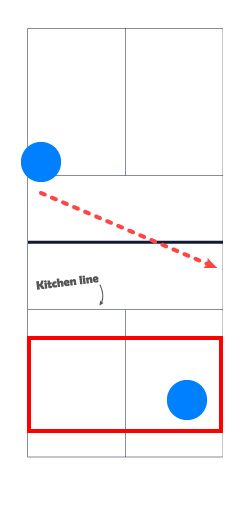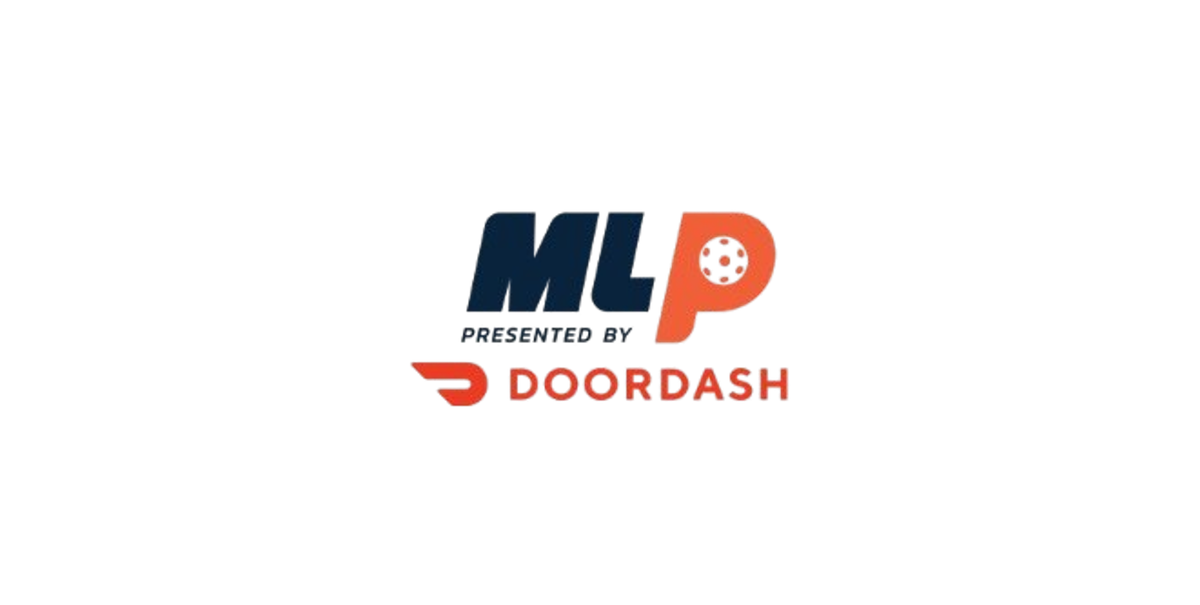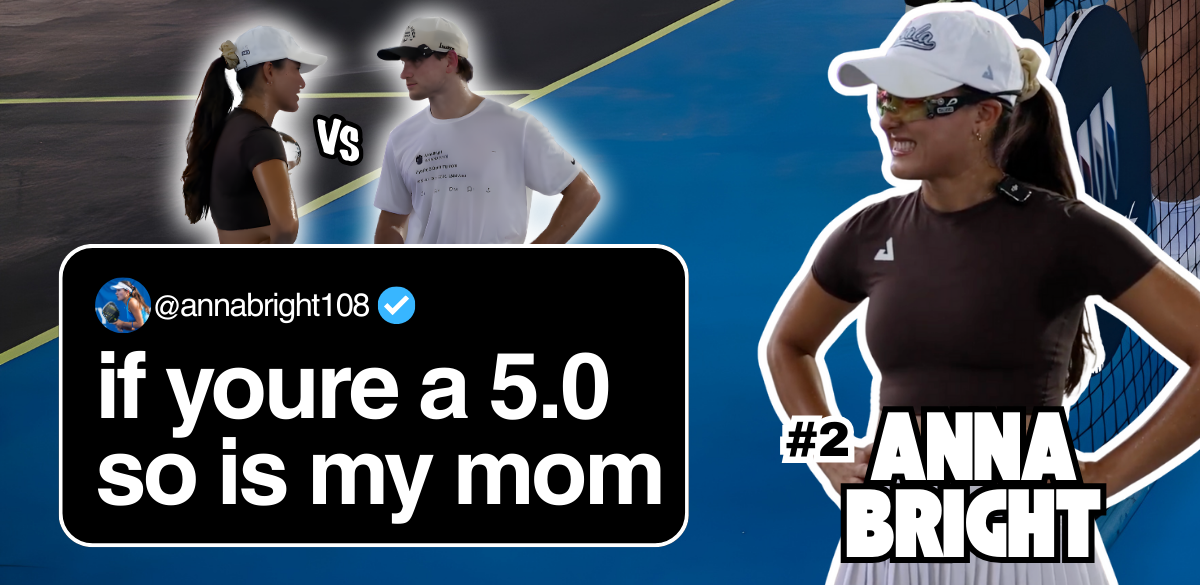One of the most frustrating experiences we can have as athletes are making mistakes without knowing the causes or what to do about them. I’ve experienced this many times and I know exactly where beginning pickleball players are coming from. Adding on top of that, it can be hard to get information about proper pickleball strategy and technique considering the youth of the sport. I’m going to help you out today by talking about a number of common beginner pickleball mistakes that people make and how to get rid of them.
Before we begin, I want to share something important with you. I’ve made all of the mistakes that you see on this list. Every single one of them. This is why I know how to talk about them. Although I’m going to go through how to fix these issues, remember that changing anything about your pickleball game will take time! So stick with it!
Staying in no man’s land
Throughout a pickleball point, there are two main places to stand: the baseline and the kitchen line. For the most part, you shouldn’t be standing in any other area on the court. If you’re not standing in one of these areas then you’re standing in a place called no man’s land.
Hanging out in no man’s land is a very common and consistent mistake that beginners, and even intermediate players, make. It’s OK, I’ve done it too. “Staying in no man’s land” means standing in the area between the baseline and the kitchen line. This is the last place that you want to be standing and here’s why.

Right off the bat, standing in the no man’s land means that it’s easier for your opponent to hit shots towards your feet. Attempting to return these shots are difficult by itself, but even harder because you’re typically running at the same time. Returning a shot to your feet while running is borderline impossible. And if you do manage to make contact with the ball, it will either sail up into the air for your opponent to smash, or go right into the net.
The other reason why you don’t want to be in no man’s land is that you are vulnerable to cross-court dinks. Check out this image.

Imagine you’re the blue circle at the bottom of the image. Since you’re in no man’s land, an opponent can simply hit a cross-court dink and it will be nearly impossible to return. However, if you were standing at the kitchen line, then you’re able to return the shot easily.
It’s true that an opponent can simply lob a shot over you while you’re standing at the kitchen line. However, lob shots are typically risky and can either be smashed or they can go out. A cross-court dink is much safer and much more effective.
If you want to improve your game, make sure you get up to the kitchen line once the serve and return-serve have been executed!
Hitting to the opponent’s forehand
One of the foundational concepts to learn in pickleball is to let your opponent make the mistakes. Many games are won just by your opponent doing all the work for you. But by hitting to the opponent’s forehand, you’re making it easy for them. Instead, let’s make it hard. Let’s hit to their backhand instead.
Most pickleball players, regardless of skill level, are weaker with their backhand than their forehand. This doesn’t mean that everyone is, but most people are, especially at the recreational level. Knowing this, which side would you rather hit to, the forehand or the backhand? The backhand of course!
There are a few important shots that you’ll want to prioritize this strategy on. They are the serve, the third shot drop, and the cross-court dink. Focus on hitting to the opponent’s backhand on these shots especially and it will make your pickleball life significantly easier.
For the cross-court dink, you’ll want to especially make sure that you do this right.
Let’s pretend for a minute that you’re on the left side of the court and you’re dinking cross-court to your right. Let’s also assume that your opponent is right-handed. The last thing you want to do is dink to their forehand. The reason is that the net is much closer to you with that angle. The more extreme the angle is, the lower the ball needs to go over the net (like if you were cross-court dinking to the sideline). If you hit the dink too high to their forehand, it’s going to be smashed.
Scooting up when you serve
This is another mistake that I used to do all the time. You don’t see this in advanced play very much because at that point most people have been caught doing this. What I typically see is after someone serves, they will begin to scoot up past the baseline. The problem is that the return serve can’t be volleyed because of the double bounce rule.
So if you scoot up past the baseline and the opponent hits a deep return serve, then you are toast! If that ball lands at your feet, then it’s very unlikely that you’ll be able to get it. And if you volley it (hit it before it bounces) it will be a fault.
The trick is to not move past the baseline when you serve. Stay back! This is especially true if you’re playing against advanced players because they likely to hit their return serves deep.
This is also relevant when your partner serves. Don’t scoot up when they serve because it’s possible that you’ll be the one hitting it back.
Getting too fancy with spin shots
I used to be a total spin junky. I love pickleball, but what I love even more is playing fancy pickleball. Let me tell you up front, it did not end well. Unfortunately, I had to take my own medicine and stop getting fancy with spin.
There’s nothing wrong with using spin shots every now and then, but using them all the time is probably going to lead to more mistakes. Also, spin shots don’t work very well on advanced players because they understand them and have played against them so much. So if you’re using spin shots against great players, you’re risking a lot for very little reward.
The problem with most spin shots is that they take a lot of skill and accuracy to pull off. If you don’t have this kind of expertise, then you should stay away from spin shots. Just for context, I’m an advanced player and even I stay away from spin shots. Remember, winning in pickleball is about consistency, persistence, and strategy, not as much about trickery and cunning.
Look, I’m not saying that you should never put spin on any of your shots. But it needs to be used intelligently. Spin shots can be devastating, but they should be used as a tool and not a regular shot.
Playing with a paddle that doesn’t compliment you
If you’ve consumed a lot of my content, then you know at this point that I’m a total paddle junkie. I constantly harp on getting the best kind of paddle for you.
But before I go on a rant about paddles, I have to talk about a principle behind the paddle choosing process. I call it the “First Commandment Of Pickleball Paddle Choice”.
Thou shalt not blame thy pickleball mistakes on thy pickleball instrument.
Something like that.
I say this to people all the time because it’s so important. Unless your paddle is made of a nightmarish amalgamation of bananas and tree bark, you have to try to avoid blaming your mistakes on the paddle. I know; it’s tempting. But skill and technique are #1 when it comes to advanced pickleball play.
However, there’s a limit to this. Playing with a paddle that doesn’t fit your game at all can make a major difference. Upgrading to a higher quality paddle can help immensely. Here are some common signs that you’re using a paddle that compliments you well.
- You don’t get any serious wrist, elbow or arm fatigue.
- The paddle is light enough to give you quickness but heavy enough to get power.
- It’s not a wooden paddle and is in a decent price range ($60-150).
I’m not a doctor, so don’t take anything I say as medical advice, but if your paddle is giving you any arm fatigue then you should stop using it and find a lighter paddle. Either get a kitchen scale and weigh your paddle or look online at pickleballcentral.com to find the weight. What makes a paddle heavy or light is going to depend on your personal strength. It’s relative.
For example, a 7.1 oz paddle is lightweight to me (I’m 31 at the time of this writing), but for a 90-year-old woman that might be the perfect weight for her.
The #1 most important factor in choosing a pickleball paddle is weight. Try to use other people’s paddles and find out how the differences in weight affect your experience. Try light paddles, heavy paddles and everything in between until you get a good feel for what you like.
Just getting the proper weight down for you will make an enormous difference in your game.
Using only a power game
Hitting the ball as hard as possible can be a fun part of pickleball. I remember wanting to hit every shot hard in my early pickleball days. Unfortunately, this strategy doesn’t work very well at higher levels of play. There are two main reasons for this.
The first reason is centered around risk and reward. By their nature, power shots, third shot drives especially, are unruly and unpredictable. One of the things that can make them effective against an opponent is how fast and random they are. When your opponent is winding up a huge swing at you, it can be a bit jarring figuring out where the ball is going to go.
That’s an advantage, but that’s also a disadvantage.
Power shots such as the third shot drive can easily go into the net or out the baseline. In fact, most of the third shot drives that I see go into the net.
The second reason is that third shot drives don’t work on advanced players. At this point in their game, they have seen and blocked so many power shots that it just doesn’t work on them anymore. If you hit a third shot drive at an advanced player, they will simply block it into the kitchen and there’s nothing that you can do about it.
I’m not saying that power isn’t useful. Quite the contrary. What I’m saying is that it’s not used all the time, and it should never be replaced with finesse. Instead, try using third shot drives and other power shots (excluding overhead smashes) as a tool and not a shot to use consistently.
Not taking center-court shots as the forehand player
This mistake doesn’t only show up with beginner and intermediate players. It also shows up if there’s a lack of communication on the team regardless of skill level.
In pickleball, whoever is the dominant forehand player will take shots that go up the middle. Of course, this is dependent on whether you are left or right-handed. But let’s just pretend for a second that both of you and your partner are right-handed. If you’re on the left side of the court, then you will take every shot that goes up the middle, including smashes.
The reason is that the player on the left is able to use their forehand. Like I mentioned earlier, the forehand is much easier to use.
Not sprinting to the kitchen
Pickleball is primarily played at the kitchen. Not the baseline, not the middle of the court, but at the kitchen. It’s important to get to the kitchen as quickly as you can. SImilar to what I said about no man’s land, if you saunter around in the middle of the court, you’re a target waiting to be smashed to. And you certainly don’t want that!
If you lack mobility and you can’t sprint, just try to get up to the kitchen as quickly as you can. If a ball is heading your way while you’re running to the kitchen, stop in your tracks and focus on getting the ball back over. Running to the kitchen and returning a ball at the same time is a difficult task to accomplish and will often lead to popping the ball up for your opponent to easily smash.
Poaching when it’s not required
Before I get into the details about this one, I’d like to explain what poaching is.
Poaching is akin to stealing your partner’s shot. During a dinking rally, have you ever had your partner scoot over into your area and hit a shot for you. Annoying isn’t it?
Well, poaching is actually an advanced strategy that players use. If you ever watch a very advanced game, you will typically see the players “stacking”. This means that one player will always be on either side of the court. So if you’re playing in a doubles mixed game, then the man will typically be on the left and the woman on the right. Throughout the match, the man will scoot over and poach any forehand smashes that come their way. This is poaching, but done effectively.
Where poaching is not done effectively is when you’re just doing it for no reason. Poaching can be risky because you’re leaving such a huge gap in the court when you scoot over. If the opponent takes advantage of that, the point is over. If you’re going to poach, make sure it’s a shot that your opponent can’t recover from.
Also, it can be discourteous to poach your partner if they don’t know you’re going to do it. If you want to poach, make sure you talk to them before the game to make sure it’s fine with them.
Getting into dinking battles with players better than you
I love cross-court dinking and I love it more when I get into cross-court dinking battles. You know how they are. They’re fun, exhilarating and they test your skill as a pickleball player. However, getting into a cross-court dinking battle is risky business if you don’t know what you’re doing.
Here’s how to avoid disaster. When you’re cross-court dinking with someone who is clearly better than you, count the number of times you dink it across to them. Once you they return your third dink, initiate a bailout dink. This means that instead of dinking it back to them, you dink to the opponent in front of you. This straightaway dink ensures that you don’t lose to the better dinker and switches up the momentum.
Also, if your partner is better at cross-court dinking that you are, then you can use this strategy to try to get their dinking skill into the game.
Hitting shots you know you don’t have
Everyone has trouble with this one. In fact, in an effort of full transparency, I still have trouble with this concept. Pickleball is so fun. And when you’re having fun the last thing you want to do is hit boring shots that you know how to do. Why not hit seemingly impossible shots that are super fun to do?
Well, if you’re trying to improve and get better, this is the last thing you want to do. Attempting shots that you know you can’t do is going to lead to disaster. Believe me, I know. Some of my really bad shots that I don’t have mastered go so far out of bounds that I’m convinced they land in a different zip code.
To clarify, this doesn’t mean that you don’t hit shots that are important. For example, one of the most important shots to learn is the third shot drop.
Attempting smashes on low balls
Oh boy, this is a good one. I see this one all the time. Have you ever seen someone smash a ball into the net when they’re at the kitchen line? That’s what this mistake refers to.
This typically happens when an opponent has hit a third shot drop that was just a bit too high, but not high enough. The ball ends up being in this awkward zone where you know you can volley it easily, but you’re not sure if you can smash it or not. A lot of beginners will reach into the kitchen and try to whip the ball down. It goes into the net almost every time.
To avoid this mistake, instead of smashing it, just push your paddle in the direction you want it to go in. The problem is reaching into the kitchen to smash the ball. When you perform an overhead smash, the face of the paddle is heading towards the floor, instead of heading for the opponent’s court. Since the ball is so far in front of you, you end up hitting the ball at the end of the arc, instead of at the top. This is what causes the ball to go into the net.
But, if you push the paddle in the direction you want it to go in, you’ll produce a shot with far less power, but far greater accuracy. This is what you want in pickleball.
Hitting an opponent’s power shot too hard
Have you ever had someone hit a hard drive at you and you smacked it with your paddle only to see the ball sail out of bounds? If you’re nodding your head, so am I. I’ve done it many times until I learned how to block power shots properly. Let me give you the short answer.
Stop swinging at power shots!
Power shots are coming so hard at you that nothing else is needed to get the ball back over the net. The key to stopping mistakes in this area is to not swing at the ball. That ball doesn’t need any more power.
The best way to return a shot like this is to just block it instead. Simply stick out your paddle and let the ball collide. Don’t try to hit it.
Believe me, this is not easy. This takes time and patience to get under control. But once you learn this it will change the way you face power players forever!
Wrapping up
Always remember that getting better at pickleball takes time and patience. It’s not easy. Pickleball is a very complex sport that requires a lot of practice and effort. Keep at it and you’ll be great in no time! If you have any questions or comments feel free to use the comment section below!
Anuncie Aqui / Advertise Here
Sua marca para o mundo Pickleball! / Your brand for the Pickleball world!

 English
English  Spanish
Spanish  Portuguese
Portuguese  German
German  Italian
Italian  Japanese
Japanese  French
French  Polish
Polish  Russian
Russian  Netherlands
Netherlands  Hungarian
Hungarian  Turkish
Turkish  Videos
Videos  Pickleball Kitchen
Pickleball Kitchen








 English (US) ·
English (US) ·  Portuguese (BR) ·
Portuguese (BR) ·